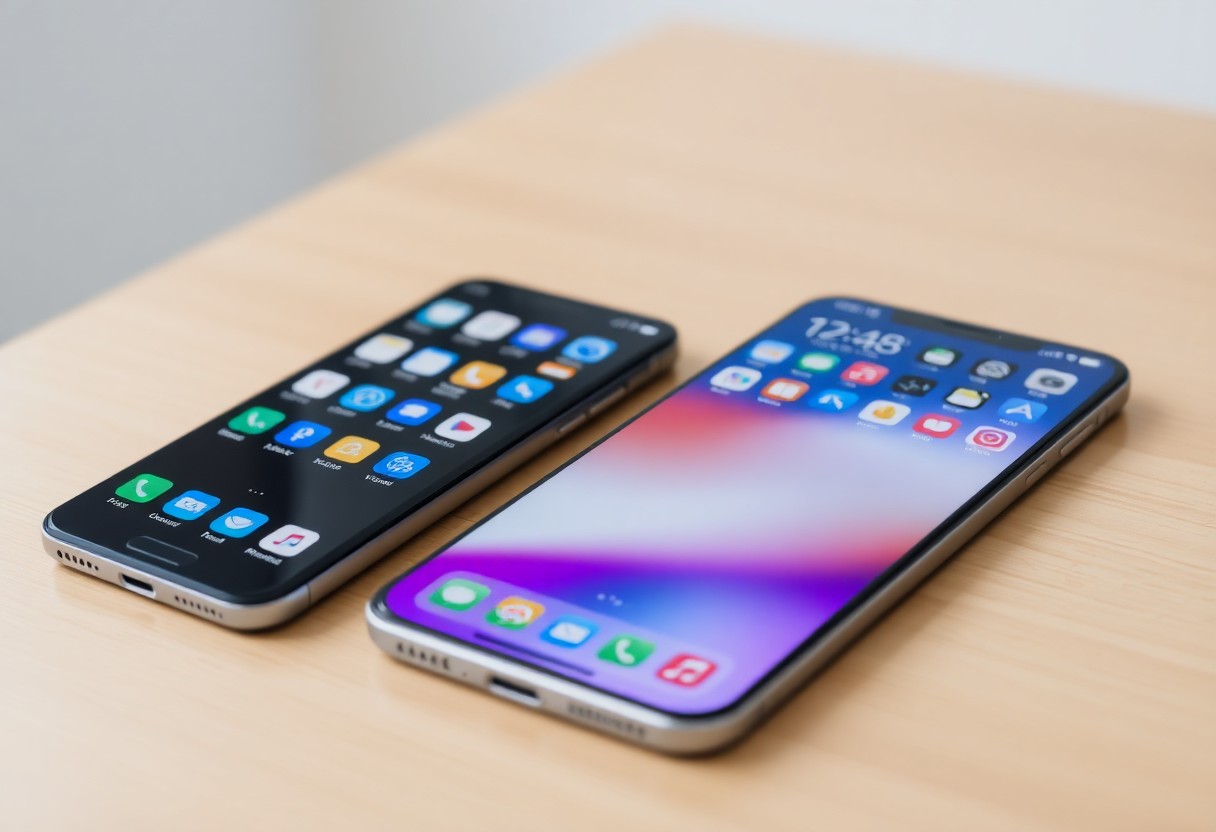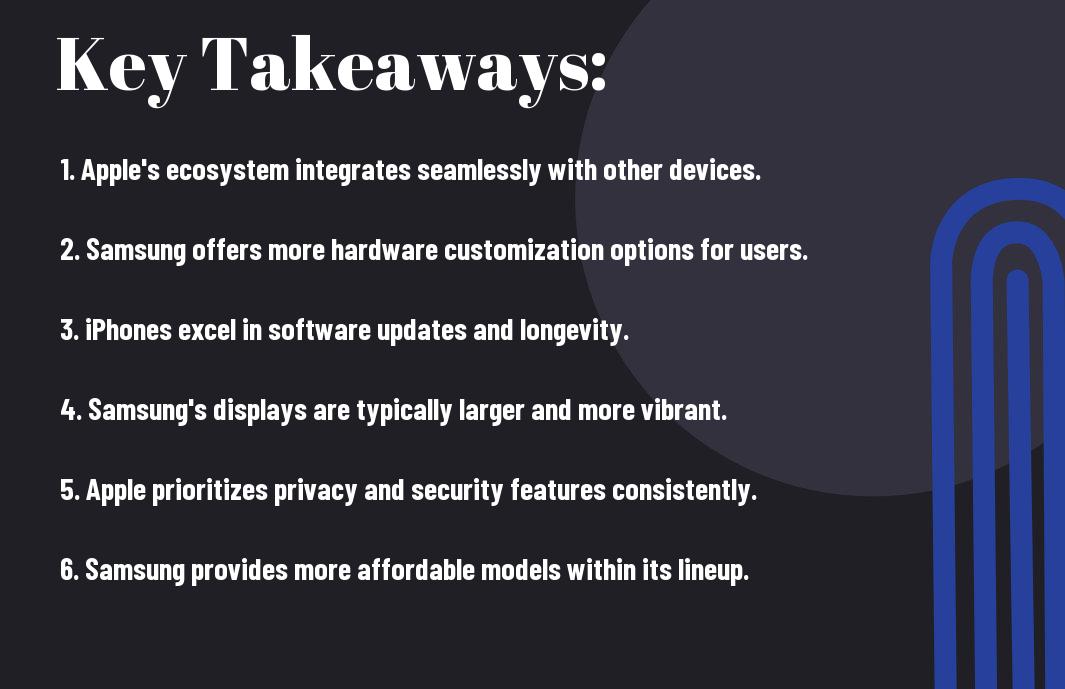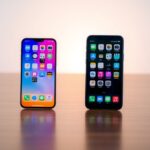The Ultimate Comparison – Apple Vs. Samsung Smartphones You Need To Read
Over the years, smartphone enthusiasts like you have debated the superiority of Apple and Samsung devices, each brand boasting distinct features that cater to different needs. In this comprehensive comparison, you’ll discover key differences in design, performance, and ecosystem integration, as well as important advantages that can significantly impact your user experience. By examining these factors, you can make an informed decision that best suits your lifestyle and preferences, ensuring you get the most value from your next smartphone investment.

Key Takeaways:
- Design & Build Quality: Apple focuses on premium materials and aesthetics with their sleek designs, while Samsung often offers a more diverse range of designs and features, including the innovative folding options.
- Camera Performance: Both brands excel in camera technology, but Apple prioritizes natural color accuracy and video stabilization, whereas Samsung tends to emphasize high megapixel counts and versatile features like zoom capabilities.
- Operating System Experience: iOS provides a seamless ecosystem experience and regular updates, attracting those who prefer simplicity. On the other hand, Samsung’s Android skin allows for more customization and flexibility in user experience.

The Evolution of Smartphones
While the smartphone market has transformed rapidly over the last two decades, brands like Apple and Samsung have led the charge, each introducing groundbreaking innovations. Understanding their journeys provides a deeper appreciation for the devices you hold in your hand today.
Brief History of Apple Smartphones
To appreciate Apple smartphones, you must look back to 2007, when Apple introduced the first iPhone, revolutionizing mobile technology. The iPhone combined a touchscreen interface, internet browsing, and a sleek design, quickly becoming a game-changer in the smartphone industry.
Brief History of Samsung Smartphones
Briefly, Samsung has been a prominent player in the mobile world since the late 1990s. Initially, the company focused on feature phones, but in 2010, it made a significant impact with the release of the Galaxy S, marking its entry into the competitive smartphone arena.
Another important milestone for Samsung came with the introduction of the Galaxy Note series in 2011, which popularized the phablet category. This innovation paved the way for larger-screen devices that have since become highly sought after, allowing consumers to enjoy both productivity and entertainment on a single device.
Key Innovations by Apple
With every new iPhone release, you see Apple setting trends with features like the App Store, Face ID, and a focus on privacy and security. Each innovation has shaped the smartphone experience while prioritizing user experience.
A significant achievement for Apple was the introduction of the Retina display, which offered users vibrant color and clarity that was unmatched at the time. Furthermore, Apple’s ecosystem—composed of devices like the iPad and Apple Watch—allows seamless integration, enhancing usability and connectivity across products.
Key Innovations by Samsung
Apple may have many accolades, but Samsung has also made impressive strides in smartphone technology, such as introducing edge displays, wireless charging, and advanced camera systems that capture stunning images in various lighting conditions.
Samsung has consistently pushed the envelope, exemplified by innovations like the Galaxy Fold, heralding a new era of foldable smartphones. This feat of engineering showcases Samsung’s commitment to adapting and evolving, enabling you to enjoy a versatile device that can fit seamlessly in your pocket while offering a larger display when needed.
Operating Systems
Now, let’s examine into the operating systems that power Apple and Samsung smartphones, two giants that cater to diverse user experiences.
iOS Overview
Along with its sleek design and intuitive features, iOS provides a seamless integration with other Apple products, making it a preferred choice for users already embedded in the Apple ecosystem.
Android Overview
Below the surface, Android boasts an extensive and flexible operating system, allowing manufacturers like Samsung to customize their devices for unique user experiences.
Overview of Android shows that it is open-source and offers a wide range of apps on the Google Play Store. This platform enables greater accessibility and offers many customization options, catering to your specific needs and preferences. Its compatibility with a variety of devices adds to its versatility, making it a popular choice for users who seek personalization.
User Interface and Experience
User experience is paramount, and with iOS, you enjoy a consistent and user-friendly interface that ensures familiarity across different devices, facilitating a quicker learning curve.
In addition, Android’s user interface provides more customization options which allows you to tailor your device to your liking. Whether it’s changing home screen layouts or installing third-party launchers, Android delivers a personalized experience that emphasizes your individual style, enabling you to navigate your smartphone effortlessly.
Software Updates and Support
One key consideration is that Apple tends to provide regular software updates for its devices, ensuring that you receive the latest features and security enhancements throughout your device’s life.
And when it comes to Android, the update schedule can vary widely depending on the manufacturer and model. This inconsistency means you have to be vigilant about updates with Samsung devices, as they may not receive the same level of long-term support as their Apple counterparts. It’s important to evaluate these factors to ensure your smartphone remains secure and functional over time.
Design and Build Quality
For anyone considering a smartphone, the design and build quality are fundamental aspects. Apple and Samsung have developed distinct philosophies that reflect their brand identities, ultimately influencing your decision when choosing between their devices.
Apple’s Design Philosophy
Against the backdrop of sleek minimalism, Apple emphasizes a clean, functional aesthetic that often prioritizes simplicity and sophistication. Each design iteration showcases an unwavering commitment to consistency and visual appeal, ensuring that your device feels premium in every aspect.
Samsung’s Design Philosophy
By contrast, Samsung embraces innovation and diversity in its design approach. With a variety of models and styles, Samsung caters to a broader audience, ensuring you have ample choices that suit your personal preferences and lifestyle.
In fact, Samsung often pushes the envelope with bold colors, unique shapes, and cutting-edge technology, making their devices stand out in a crowded market. Your choice of a Samsung smartphone allows you to express your individuality while enjoying advanced features that complement your daily needs.
Materials and Durability
Samsungs are known for their impressive build quality, often utilizing premium materials such as glass and aluminum to enhance both aesthetics and durability. Their flagship devices undergo rigorous testing to withstand everyday wear and tear, ensuring you have a reliable companion.
Indeed, Samsung’s attention to detail in choosing materials translates into sturdy phones that resist damage better than many competitors. This commitment to durability helps you feel secure in your investment, knowing that your device can withstand the rigors of daily life.
Size and Ergonomics
One of the key aspects you should consider is how a phone feels in your hand. Apple typically opts for a more compact design with easy-to-reach controls, enhancing usability regardless of your hand size. This ensures that you can comfortably navigate your device.
Considering the ergonomic features, Samsung offers a wide range of sizes, allowing you to choose from smaller models to larger smartphones. This versatility means you can select a device that balances screen size with comfort, matching your preferences for both functionality and ease of use.
Camera Comparisons
Despite the ongoing debate among consumers and tech enthusiasts, one of the most significant differentiators between Apple and Samsung smartphones is their camera capabilities. Below, you’ll find a comparative breakdown of the key camera specifications of both brands, helping you decide which option best suits your needs.
Camera Specifications: Apple vs. Samsung
| Feature | Apple |
|---|---|
| Primary Camera | 12 MP Wide, 12 MP Ultra Wide, 12 MP Telephoto |
| Night Mode | Yes |
| Video Recording | 4K up to 60 fps |
| Front Camera | 12 MP TrueDepth |
| Feature | Samsung |
|---|---|
| Primary Camera | 108 MP Wide, 12 MP Ultra Wide, 10 MP Telephoto |
| Night Mode | Yes |
| Video Recording | 8K up to 30 fps |
| Front Camera | 40 MP |
Camera Specifications: Apple vs. Samsung
After analyzing the specifications, it’s evident that both Apple and Samsung offer advanced camera features. Apple’s system focuses on software optimization, providing consistent performance across various lighting conditions, while Samsung boasts higher megapixel counts, allowing for greater detail in well-lit environments.
Real-World Photography Tests
The real-world tests reveal how each camera performs outside of controlled conditions. Users can experience firsthand the differences in color accuracy, detail retention, and low-light capabilities, which are important in everyday usage. This can greatly impact your choice depending on your photography preferences.
It is important to consider factors like dynamic range and color science when comparing the cameras. While Apple is often praised for its true-to-life colors and balanced exposure, Samsung’s images can be more vibrant and saturated, which appeals to users looking for more striking visuals.
Video Recording Capabilities
Apple has always been known for its video recording capabilities, offering smooth stabilization, high quality, and several shooting modes. This ensures that you can capture professional-looking videos with ease, making it a favorite among content creators.
In fact, Apple’s dominance in video recording comes from its expert software tuning and seamless integration of features like Dolby Vision HDR. This not only allows for brilliant video capture but also ensures incredible playback quality on compatible devices, setting a high standard in the smartphone market.
Special Features in Camera Applications
Camera applications in both ecosystems provide unique functionalities that enhance your photography experience. Both brands include features that cater to different user needs, making it important for you to explore these options.
Recording special moments takes on a new life with features such as ProRAW in Apple, offering photographers enhanced editing capabilities, while Samsung provides options such as Single Take Mode, which captures multiple photos and videos with one click. This flexibility allows you to choose based on your shooting style and preferences.
Performance and Hardware
Your choice between Apple and Samsung smartphones greatly impacts your everyday experience, particularly regarding performance and hardware. These two industry giants utilize cutting-edge technology, but their approaches differ significantly.
Processing Power
Behind the scenes, both Apple and Samsung utilize advanced chipsets to deliver outstanding performance. Apple’s A-series chips, like the A15 Bionic, are recognized for their efficiency and speed. Conversely, Samsung’s Exynos and Snapdragon processors provide robust performance, especially in multitasking scenarios. This processing power plays a vital role in how smoothly applications run and how quickly tasks are completed on both platforms.
RAM and Multitasking Efficiency
Behind the performance metrics lies the critical factor of RAM. Apple typically offers lower RAM compared to Samsung, but their optimizations allow for effective multitasking. Samsung, with its generous RAM offerings, excels in handling multiple tasks simultaneously.
Multitasking is where the differences become evident. You may find that Apple’s iOS efficiently manages memory, giving you a seamless experience even with lesser RAM. On the other hand, Samsung’s Android interface allows extensive customization, making it effective for users who frequently switch between apps. This capability can enhance your overall experience depending on your usage habits.
Battery Life and Charging Technology
The performance isn’t just about speed; it also includes battery life and charging capabilities. Both Apple and Samsung have made significant advancements, but their strategies differ. Apple focuses on optimal battery optimization, ensuring you get through the day, while Samsung offers larger battery capacities with fast charging and wireless options.
Even with their strong battery performances, you should consider the integrated charging technology. Apple’s commitment to efficiency can make the most out of smaller batteries, delivering longer life in some cases. Samsung, however, brags about rapid charging features, allowing you to quickly power up when needed. Your preference may depend on whether you prioritize long-lasting power or swift charging.
Storage Options and Expandability
Behind the scenes, storage options can heavily influence your choice of smartphone. Apple typically offers set storage configurations without expandability, while Samsung provides various options, including microSD support. This choice significantly affects how much data you can store and access easily.
Options are a key aspect of the storage debate. If you need flexibility in managing your files, Samsung’s microSD capability can be a game changer, allowing you to tailor the storage according to your needs. In contrast, if you prefer a streamlined experience without extra management, Apple’s ecosystem may simplify your life, albeit at a fixed capacity. Your decision on storage could very well align with your lifestyle and data usage patterns.
App Ecosystem and Services
Once again, the competition between Apple and Samsung unfolds in their respective app ecosystems and services. Each platform offers unique benefits that cater to different preferences and needs, shaping how users engage with their smartphones.
App Store vs. Galaxy Store
To compare the App Store and Galaxy Store, you’ll find that Apple’s App Store tends to feature a more extensive selection of high-quality applications, often prioritized by developers. Meanwhile, Samsung’s Galaxy Store offers tailored apps specifically designed for Samsung devices, providing exclusive features that enhance user experience.
Exclusive Applications and Services
About exclusive applications, Apple excels with its productivity suite, including iMovie and GarageBand, which you can find nowhere else. Samsung, on the other hand, provides applications like Samsung Health and Samsung Pay, which you may find particularly integrated with its hardware offerings.
The distinctiveness of these exclusive applications adds significant value to your smartphone experience. With Apple, you gain seamless integration with services like iCloud and Apple Music, while Samsung offers a robust ecosystem with enhanced connectivity to its smart devices and appliances, ensuring that you’re connected seamlessly across all your tech.
Third-Party App Support
Against this backdrop, third-party app support shines differently for both platforms. Apple offers a more stringent review process, ensuring quality but sometimes limiting app availability, while Samsung’s Galaxy Store allows for greater flexibility and a wider variety of options, though quality can be inconsistent.
Services on the Samsung platform often enable you to experiment with a wider range of apps without as many restrictions. This flexibility can lead to discovering lesser-known gems that might not pass Apple’s rigorous standards. However, this comes with the risk of potentially lower-quality apps that might not perform as well as those in the App Store.
Security and Privacy Considerations
Behind the scenes, both Apple and Samsung prioritize your security and privacy, but the approaches differ. Apple’s stringent policies and robust encryption efforts aim to safeguard your data, while Samsung provides security features such as Knox, designed to protect your personal information.
Also, understanding the nuances of each system’s security is important. Apple’s closed ecosystem minimizes vulnerabilities but leaves less room for customization. In contrast, Samsung’s open approach offers more flexibility but may expose your device to greater risks. Balancing privacy with usability is key in deciding which platform aligns with your values and lifestyle.
Pricing and Value
After comparing the fundamental features and specifications of Apple and Samsung smartphones, it’s vital to investigate their pricing strategies to determine the best value for your money.
Initial Pricing Models
Pricing in the smartphone market varies significantly at launch. Apple typically positions its iPhones at a premium, ensuring a first-class user experience. In contrast, Samsung offers a broader range of models, allowing for various price points depending on specifications, which can make their devices more accessible to budget-conscious consumers.
Resale Value Comparisons
One way to measure value is by looking at resale prices. The table below outlines the average resale values for select models from both brands one year after purchase.
| Apple iPhone | Samsung Galaxy |
|---|---|
| iPhone 14: 75% | Galaxy S23: 58% |
| iPhone 13: 72% | Galaxy S22: 54% |
One important aspect to consider is that Apple devices tend to depreciate at a slower rate compared to Samsung. This means that if you choose an iPhone, you could potentially recoup more of your initial investment when it’s time to sell or trade in your device.
Financing Options
Any savvy buyer knows that financing can greatly affect your experience. Both Apple and Samsung offer financing plans, allowing you to spread payments over time, making higher-end devices more attainable.
Understanding the financing options provided by both manufacturers can enhance your purchasing power. Apple has its own financing program through the Apple Card, while Samsung has partnerships with various financial institutions to offer flexible payments. Ensure you read the fine print, as interest rates and terms can significantly impact your overall cost.
Cost of Ownership over Time
Around the end of your device’s lifespan, assessing its total cost of ownership becomes vital. Both brands present different experiences in terms of software updates, battery longevity, and support services, all of which can affect your budget in the long run.
With Apple devices often receiving longer software support, you may find yourself needing to upgrade less frequently than with a Samsung device, leading to enhanced cost efficiency over time. However, consider your usage habits, as they can also influence the overall duration of your device’s effectiveness before needing to invest in a replacement.
Summing up
Hence, as you weigh the benefits of Apple and Samsung smartphones, consider your own priorities, such as operating system preference, camera quality, design, and ecosystem compatibility. Both brands offer exceptional devices that cater to various needs, so understanding what aligns with your lifestyle will guide you in making an informed decision. Whether you lean towards the seamless integration of Apple or the customizable features of Samsung, your choice will ultimately reflect your personal needs and preferences in a smartphone.
FAQ
Q: What are the main differences between Apple and Samsung smartphones?
A: The primary differences between Apple and Samsung smartphones lie in their operating systems, design philosophies, and hardware specifications. Apple uses iOS, which is known for its smooth user experience and integration with other Apple products. Samsung smartphones predominantly use Android, offering more customization and variety in hardware options. While Apple focuses on a minimalistic design with premium materials, Samsung often emphasizes cutting-edge technology and innovation in display and camera features.
Q: How do the cameras compare in Apple and Samsung smartphones?
A: Camera performance varies between Apple and Samsung smartphones, with both brands offering impressive capabilities. Apple devices, like the iPhone, tend to produce natural-looking photos with accurate colors and strong performance in low-light conditions. Samsung smartphones, such as the Galaxy series, often excel in zoom and wide-angle shots and feature more versatile camera modes. While the aesthetic of photos can differ, personal preference usually dictates which brand users prefer for photography.
Q: Which brand is better for software updates and longevity?
A: Apple’s iPhones typically receive software updates for a longer duration. Apple supports devices with the latest iOS updates for about five to six years after their release, ensuring that even older iPhone models can take advantage of newer features and security improvements. On the other hand, while Samsung does provide updates, the duration and frequency may vary by model and carrier. Generally, flagship Samsung models receive better support compared to the budget or mid-range versions.
Q: How does battery life compare between Apple and Samsung smartphones?
A: Battery life can depend on various factors, including the specific model and user habits. Historically, Samsung smartphones have offered larger battery capacities, which can translate to longer use between charges. Apple, on the other hand, focuses on optimization with its hardware and software, often resulting in impressive real-world battery performance despite lower capacity on paper. It is advisable to check reviews and benchmark tests for specific models to gauge their performance in daily use scenarios.
Q: Which smartphones provide better privacy and security features?
A: Generally, Apple tends to emphasize privacy and security features more prominently than Samsung. Apple incorporates various built-in features, such as encryption for iMessages and FaceTime calls, as well as strict App Store guidelines to ensure user safety. Meanwhile, Samsung also offers solid security features, including Samsung Knox, but has faced scrutiny over its reliance on the Android ecosystem, which can present potential vulnerabilities. Final choice may depend on the user’s personal priorities regarding privacy and security comfort levels.





